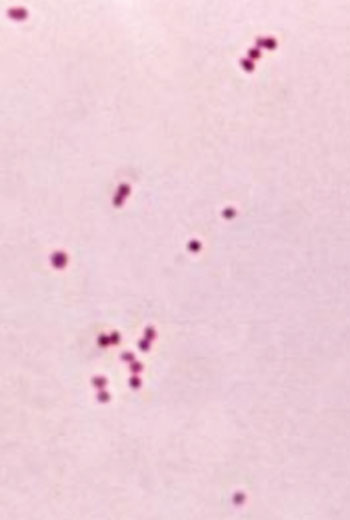Infection by Meningitis Bacteria Depends on Dimerization State of Certain Host Cell Proteins
By LabMedica International staff writers
Posted on 16 Oct 2014
A team of molecular microbiologists has untangled the complex three-way interaction between the non-integrin laminin receptor (LAMR1), galectin-3 (Gal-2), and the pathogenic bacterium Neisseria meningitidis.Posted on 16 Oct 2014
Neisseria meningitidis, the causative agent of meningococcal meningitis, is found in the nasopharynx of humans but not in other animals. How this organism interacts and invades tissues has been of great interest to medical microbiologists. In the current study, investigators at The University of Nottingham (United Kingdom) examined the roles of two host cell-surface proteins, Galectin-3 and laminin receptor 1, in the process of infection.

Image: This micrograph depicts the presence of aerobic Gram-negative Neisseria meningitidis diplococcal bacteria; magnification 1150x (Photo courtesy of the CDC - US Centers for Disease Control and Prevention).
Galectin-3 (Gal-3) is one of the 14 recognized mammalian lectins. This protein weighs approximately 30 kDa and, like all galectins, contains a carbohydrate-recognition-binding domain of about 130 amino acids that enables the specific binding of beta-galactosides. Gal-3 is expressed in cells in the nucleus, cytoplasm, mitochondrion, cell surface, and extracellular space. This protein has been shown to be involved in cell adhesion, cell activation and chemoattraction, cell growth and differentiation, cell cycle, and apoptosis. Gal-3 recognizes the Thomsen-Friedenreich disaccharide (TFD, galactose-N-acetylgalactosamine) that is present on the surface of most cancer cells and is involved in promoting angiogenesis, tumor-endothelial cell adhesion, and metastasis of prostate cancer cells, as well as evading immune surveillance through killing of activated T-cells.
Laminins, a family of extracellular matrix glycoproteins, are the major noncollagenous constituent of basement membranes. They have been implicated in a wide variety of biological processes including cell adhesion, differentiation, migration, signaling, and metastasis. Many of the effects of laminin are mediated through interactions with cell surface receptors. These receptors include members of the integrin family, as well as non-integrin laminin-binding proteins. The ribosomal protein SA gene encodes a high-affinity, non-integrin family, laminin receptor 1 (LAMR1). This receptor has been variously called 67-kDa laminin receptor, 37-kDa laminin receptor precursor (37LRP) and p40 ribosome-associated protein. The amino acid sequence of laminin receptor 1 is highly conserved through evolution, suggesting a key biological function.
In their paper, which was published in the October 1, 2014, online edition of the journal Open Biology, the investigators described using advanced bimolecular fluorescence and confocal imaging techniques to show that Gal-3 and LAMR1 formed homo- and heterodimers, and that each isotype formed a distinct cell surface population. The 37-kDa form of LAMR1 (37LRP) was the precursor of the previously described 67-kDa laminin receptor (67LR), whereas the heterodimer represented an entity that was distinct from this molecule. Site-directed mutagenesis confirmed that the single cysteine (C173) of Gal-3 or lysine (K166) of LAMR1 were critical for heterodimerization. Recombinant Gal-3, expressed in normally Gal-3-deficient N2a cells, dimerized with endogenous LAMR1 and led to a significantly increased number of internalized bacteria, confirming the role of Gal-3 in bacterial invasion.
Contributing author Dr. Karl Wooldridge, associate professor of microbiology at The University of Nottingham, said, “We have shown evidence for the self and mutual association of these two important proteins and their distinctive surface distribution on the human cell. We have also demonstrated that they are targeted by the serious human pathogen Neisseria meningitidis. This is significant because these proteins could potentially be used to develop new vaccines and treatments which could sabotage the colonization of these dangerous bacteria, and also which could protect the blood-brain barrier which is disrupted in cases of bacterial meningitis.”
Related Links:
The University of Nottingham










 (3) (1).png)



